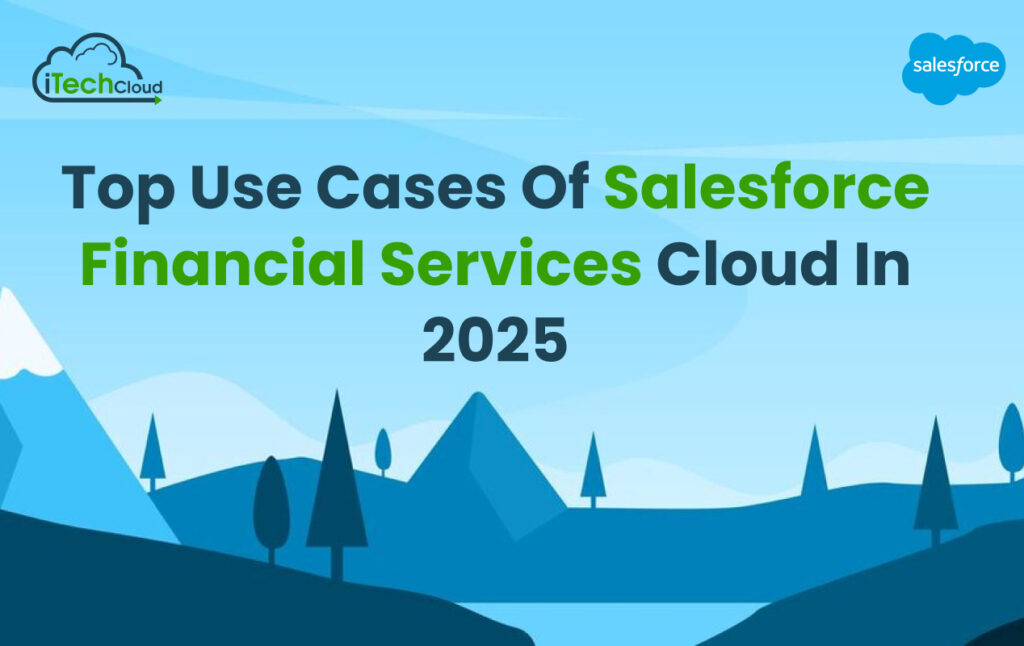Top Use Cases of Salesforce Financial Services Cloud in 2025

Salesforce Financial Services Cloud (FSC) has emerged as a game-changer for the financial industry, offering tailored solutions that improve client relationships, streamline operations, and drive business growth. As we move into 2025, the platform continues to evolve, incorporating AI, automation, and data-driven insights to address the dynamic needs of the financial services sector. From wealth management to insurance and retail banking.
Here’s a look at the top use cases of Salesforce Financial Services Cloud in 2025.
Table of Contents
1. AI-Powered Personalized Client Engagement
In 2025, hyper-personalization has become a key driver in financial services. Salesforce Financial Services Cloud leverages AI and predictive analytics to provide highly personalized financial advice and solutions. Relationship managers can now anticipate client needs based on real-time data, life events, and behavioral insights. AI-powered recommendations enable advisors to proactively offer relevant financial products, improving customer satisfaction and retention.
How It Works:
- AI analyzes client interactions, preferences, and financial history.
- Dynamic client profiles are updated automatically, allowing advisors to tailor their approach.
- Proactive nudges suggest timely actions, such as investment opportunities or insurance renewals.
Example: A wealth manager receives AI-powered recommendations about a client’s potential interest in ESG investments, prompting a personalized outreach with relevant options.
2. Automated Onboarding and Compliance Management
Client onboarding in the financial sector can be cumbersome and time-consuming, often bogged down by regulatory compliance and documentation. In 2025, Salesforce FSC automates and streamlines the onboarding process, ensuring compliance with evolving regulations while enhancing the client experience.
How It Works:
- Intelligent Document Management: Automatically verifies client documents and flags discrepancies.
- KYC and AML Automation: Ensures compliance with regulatory requirements through AI-powered checks.
- Seamless E-Signatures: Simplifies document signing and approval processes.
Example: A new high-net-worth client is onboarded in minutes, with all KYC and AML checks automatically processed and approved.
3. Holistic Financial Planning with Unified Data
In 2025, data silos are a thing of the past. Financial institutions now leverage Salesforce FSC’s 360-degree client view to consolidate data from multiple sources, including banking, investments, and insurance. This unified data model allows advisors to offer holistic financial planning and deliver more informed advice.
How It Works:
- Integrates data from CRM, banking systems, and external platforms.
- AI identifies gaps in client portfolios and suggests personalized financial strategies.
- Advisors can model future scenarios and predict outcomes based on historical data.
Example: A financial advisor uses unified data to identify gaps in a client’s retirement plan and recommends diversified investments to mitigate risk.
4. Relationship Management for Wealth Advisors
Relationship management has taken a significant leap forward in 2025 with the use of Salesforce FSC’s relationship mapping and AI-driven insights. Advisors can now visualize complex client relationships, including family hierarchies, business entities, and financial goals, ensuring a comprehensive understanding of client needs.
How It Works:
- Relationship maps display intricate family and business connections.
- AI highlights key relationship milestones and suggests engagement opportunities.
- Advisors receive actionable insights to deepen client relationships.
Example: A wealth advisor leverages relationship mapping to identify opportunities for estate planning discussions within a client’s extended family network.
5. Intelligent Insurance Policy Management
The insurance sector has significantly benefited from Salesforce FSC’s automation and AI capabilities. By 2025, insurers use FSC to manage policies, claims, and renewals more efficiently, reducing operational costs while improving customer satisfaction.
How It Works:
- Automated Claims Processing: AI predicts claim outcomes and flags anomalies.
- Renewal Reminders and Cross-Sell Opportunities: AI identifies policy gaps and suggests additional coverage.
- Policy Lifecycle Automation: Streamlines policy management and customer communication.
Example: An insurance agent uses automated alerts to remind a client about an upcoming policy renewal while suggesting a more comprehensive coverage option.
6. AI-Driven Loan Origination and Credit Risk Assessment
In 2025, financial institutions are using AI-powered loan origination and risk assessment tools within Salesforce FSC to accelerate loan approvals while mitigating credit risks. Advanced algorithms analyze client credit history, income patterns, and market conditions to provide real-time insights.
How It Works:
- AI-powered models assess credit risk and predict repayment probabilities.
- Automated workflows streamline the loan origination process.
- Real-time alerts notify advisors of potential risk factors.
Example: A mortgage advisor processes a client’s application within hours by leveraging AI insights, reducing manual underwriting efforts.
7. Seamless Collaboration Across Teams
Salesforce FSC has revolutionized cross-team collaboration by breaking down silos between advisors, service teams, and back-office operations. In 2025, seamless collaboration ensures that everyone involved in the client journey stays aligned, resulting in better service delivery and faster issue resolution.
How It Works:
- Shared dashboards and activity timelines keep all teams updated.
- AI-driven task allocation ensures smooth handoffs between teams.
- Enhanced internal communication tools facilitate real-time collaboration.
Example: A client’s portfolio review request is seamlessly coordinated between the relationship manager, tax advisor, and investment analyst, reducing turnaround time.
8. Predictive Analytics for Customer Retention
Customer retention is critical in the competitive financial landscape of 2025. Salesforce FSC uses predictive analytics to identify at-risk clients and suggests retention strategies, ensuring that institutions can proactively engage clients before they leave.
How It Works:
- AI detects behavioral patterns that signal dissatisfaction.
- Predictive models identify high-risk clients and recommend personalized outreach.
- Automated workflows trigger retention campaigns.
Example: A bank identifies clients likely to switch to competitors and sends targeted loyalty offers to retain them.
Conclusion: Salesforce Financial Services Cloud in 2025
Salesforce Financial Services Cloud continues to redefine how financial institutions operate, enabling personalized engagement, streamlined operations, and data-driven decision-making. With AI, automation, and predictive analytics at its core, FSC empowers organizations to stay ahead in a rapidly evolving financial landscape. By leveraging these top use cases, financial institutions can drive growth, enhance client relationships, and achieve long-term success.

